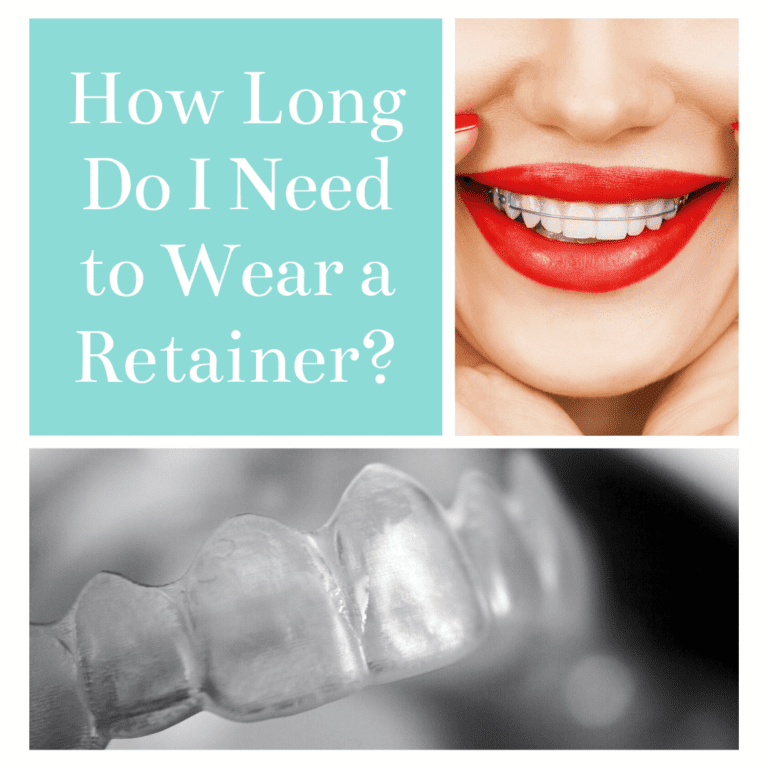How Long Do I Need to Wear a Retainer?

Nowadays, there are two orthodontic methods that are commonly used: Invisalign and braces. Both of these orthodontic appliances use different methods to achieve similar results. Invisalign utilizes clear aligners, while braces use a system of brackets and an arch wire. While these orthodontic methods are very different from one another, they have one main thing in common.
The one thing that Invisalign and braces have in common is the simple fact that you will need to wear a retainer after your treatment, regardless of the method used. Depending on your orthodontic treatment type, you may have different options for retainers. No matter which type of retainer you choose, the important thing is that you wear it as directed by your orthodontist.
What types of retainers are there?
There are three different types of retainers that your orthodontist may recommend, including:

- Hawley retainers are probably the one you are most familiar with. They are composed of a plastic or resin base that sits on the roof of your mouth behind your front teeth and a metal framework that wraps around the front of your teeth. This wire maintains proper tooth alignment, while the base keeps the retainer firmly in place. Although common in the past, Hawley retainers are not used as much anymore.
- Clear retainers are generally used after Invisalign treatment. Like the orthodontic aligners, clear retainers are made from clear aligner trays that hold the teeth in place. These are less noticeable than traditional Hawley retainers. Massih Ortho typically uses clear retainers regardless of whether braces or Invisalign was used for orthodontic treatment.
- Fixed retainers are a single wire that is cemented to the back of your teeth to keep them in place. They can be used for both the upper and lower teeth.
Why do I have to wear a retainer?
Even though your teeth are straight and your bite is properly aligned after orthodontic treatment, this can change if you don’t wear your retainer. This is because orthodontic treatment causes the bone around the teeth to slightly soften in order to allow movement. Without an appliance to “retain” the teeth’s new position, there is a risk of them shifting back to their previous position. Thus, a retainer is used to maintain the results of orthodontic treatment until the bones harden your new smile in place.
How long does this take?
It can take up to two years for your bones to completely harden and secure your teeth into their new position. Immediately after finishing active orthodontic treatment, your orthodontist will have you wear your retainer for at least 12 hours a night for the first two years. After that, you will likely be able to transition to only wearing your retainer at night while you sleep. Wearing your retainer at night is an easy way to make sure your teeth don’t shift, therefore you should continue to wear your retainer at night indefinitely.
While you may be excited to finally be done with your orthodontic treatment, it is important to remember that you will still need to wear a retainer so your results will last. To preserve your new smile, be sure to wear your retainer as directed by your dentist. After all the money and time dedicated to orthodontic treatment, you do not want to have your teeth shift back from not wearing your retainer.
 Dr. Massih attended UCLA, where she graduated Magna Cum Laude with a degree in psychobiology. She then went on to earn her DDS degree at UCLA’s School of Dentistry, where she was awarded the Dean’s Scholarship, and was in the top 10% of her class. She has received her certificate in Orthodontics and Dentofacial Orthopedics at the University of Pittsburgh and is a member of the American Association of Orthodontists, Pacific Coast Society of Orthodontists, & American Dental Association.
Dr. Massih attended UCLA, where she graduated Magna Cum Laude with a degree in psychobiology. She then went on to earn her DDS degree at UCLA’s School of Dentistry, where she was awarded the Dean’s Scholarship, and was in the top 10% of her class. She has received her certificate in Orthodontics and Dentofacial Orthopedics at the University of Pittsburgh and is a member of the American Association of Orthodontists, Pacific Coast Society of Orthodontists, & American Dental Association.

Recent Comments